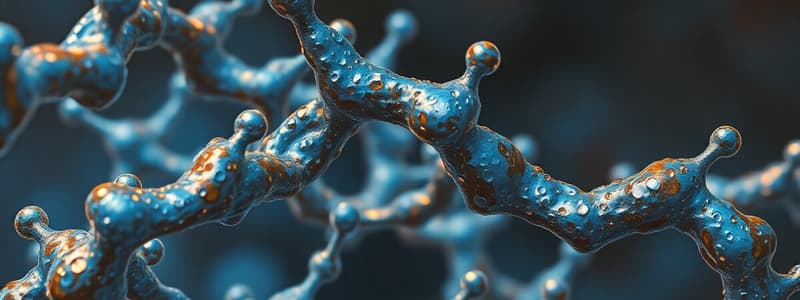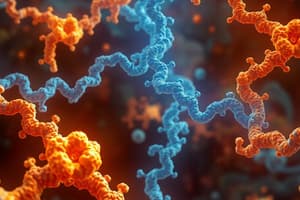Podcast
Questions and Answers
What term describes the noncovalent binding of a specific metabolite to a site other than the active site to modulate enzyme activity?
What term describes the noncovalent binding of a specific metabolite to a site other than the active site to modulate enzyme activity?
- Reversible covalent modification
- Enzyme denaturation
- Competitive inhibition
- Allosteric regulation (correct)
Which of the following is the most common type of reversible covalent modification of enzyme activity?
Which of the following is the most common type of reversible covalent modification of enzyme activity?
- Acetylation
- Phosphorylation (correct)
- Glycosylation
- Methylation
What is the term for the protein portion of an enzyme, which requires other components to be active?
What is the term for the protein portion of an enzyme, which requires other components to be active?
- Prosthetic group
- Apoenzyme (correct)
- Coenzyme
- Cofactor
Which of the following acts as a coenzyme that is essential for electron transfer in enzymatic reactions?
Which of the following acts as a coenzyme that is essential for electron transfer in enzymatic reactions?
Which of the following best describes an allosteric modulator?
Which of the following best describes an allosteric modulator?
What role does the active site of an enzyme play in its function?
What role does the active site of an enzyme play in its function?
Which statement best describes the specificity of enzymes?
Which statement best describes the specificity of enzymes?
What is the primary effect of enzymes on reaction activation energy?
What is the primary effect of enzymes on reaction activation energy?
In which stage of the enzymatic reaction does the E-S complex transform into a transition complex?
In which stage of the enzymatic reaction does the E-S complex transform into a transition complex?
How do enzymatic reactions differ from non-enzymatic reactions?
How do enzymatic reactions differ from non-enzymatic reactions?
What can modulate the activity of enzymes?
What can modulate the activity of enzymes?
What is the primary purpose of coenzymes in enzymatic reactions?
What is the primary purpose of coenzymes in enzymatic reactions?
During an enzymatic reaction, what is formed immediately after the E-S complex?
During an enzymatic reaction, what is formed immediately after the E-S complex?
What does the rate or velocity of a reaction (V0) represent?
What does the rate or velocity of a reaction (V0) represent?
What occurs at maximum velocity (Vmax) in an enzymatic reaction?
What occurs at maximum velocity (Vmax) in an enzymatic reaction?
Which factor directly decreases substrate concentration during a reaction?
Which factor directly decreases substrate concentration during a reaction?
What is a regulatory enzyme's role within a metabolic pathway?
What is a regulatory enzyme's role within a metabolic pathway?
Which statement about enzymatic kinetics is true?
Which statement about enzymatic kinetics is true?
What typically happens to reaction velocity (V0) as enzyme concentration increases?
What typically happens to reaction velocity (V0) as enzyme concentration increases?
Which of the following is NOT a factor that affects reaction rate?
Which of the following is NOT a factor that affects reaction rate?
What is the consequence of having too high or too low pH for an enzyme's activity?
What is the consequence of having too high or too low pH for an enzyme's activity?
Flashcards
Enzyme
Enzyme
A protein that speeds up a specific chemical reaction in living things.
Active site
Active site
The part of an enzyme where the substrate binds and the reaction happens.
Substrate specificity
Substrate specificity
Enzymes only bind to a particular substrate.
Enzyme efficiency
Enzyme efficiency
Signup and view all the flashcards
Enzyme regulation
Enzyme regulation
Signup and view all the flashcards
Activation energy
Activation energy
Signup and view all the flashcards
Enzyme-substrate complex
Enzyme-substrate complex
Signup and view all the flashcards
Enzymatic reaction
Enzymatic reaction
Signup and view all the flashcards
Allosteric Regulation
Allosteric Regulation
Signup and view all the flashcards
Allosteric site
Allosteric site
Signup and view all the flashcards
Allosteric Modulator
Allosteric Modulator
Signup and view all the flashcards
Reversible Covalent Modification
Reversible Covalent Modification
Signup and view all the flashcards
Phosphorylation
Phosphorylation
Signup and view all the flashcards
Enzymatic Kinetics
Enzymatic Kinetics
Signup and view all the flashcards
Reaction Rate (Velocity)
Reaction Rate (Velocity)
Signup and view all the flashcards
What is V0?
What is V0?
Signup and view all the flashcards
Maximum Velocity (Vmax)
Maximum Velocity (Vmax)
Signup and view all the flashcards
Factors Affecting Reaction Rate
Factors Affecting Reaction Rate
Signup and view all the flashcards
Metabolic Pathway
Metabolic Pathway
Signup and view all the flashcards
Regulatory Enzyme
Regulatory Enzyme
Signup and view all the flashcards
How do Metabolic Pathways change Rate?
How do Metabolic Pathways change Rate?
Signup and view all the flashcards
Study Notes
Enzymology
- Enzymology is the study of enzymes
- Enzymes are proteins that catalyze specific chemical reactions in biological systems
- Enzymes increase the rate of reactions, lowering the activation energy required
- Enzymes have a specific active site where the substrate binds
Structure of Enzymes
- Active site: the region of an enzyme surface that binds the substrate, also known as the catalytic site
- Catalytic activity depends on the native protein conformation; the surface of the active site is lined with amino acid residues that bind the substrate and catalyze the chemical transformation
- Enzymes increase the speed of reactions
Enzymes Properties
- High specificity; enzymes bind to only one substrate and catalyze a specific reaction
- Efficiency: proximity creates tension between the substrate and catalytic residues; increase the reaction rate in mild conditions, compatible with life
- Enzymatic reactions occur in specialized pockets called active sites
- Under regulation: Some agents can modulate their activity by modifying the active site
How Do Enzymes Work?
- Enzymes lower the activation energy needed for a chemical reaction to occur
- Enzymes decrease the energy needed to reach the intermediate state between reactants and products, improving reaction rates
- Enzymes form a temporary complex (enzyme-substrate complex) with the substrate
- Steps in an enzymatic reaction:
- Enzyme-substrate complex formation
- Transition-complex formation from the enzyme-substrate complex
- Formation of the enzyme-product complex
- Release of the product and the enzyme
Enzymatic Kinetics
- Study of the rate of reaction and how it changes in response to changes in experimental parameters
- Rate or velocity of a reaction (V): number of substrate molecules converted to product per unit time
Enzymatic Kinetics (External Factors)
- Factors affecting reaction rate:
- Enzyme concentration
- Substrate concentration
- pH
- Temperature
- Maximum velocity (Vmax): Maximum rate of a reaction when the enzyme is saturated with substrate
Metabolic Pathways
- Metabolic pathway: sequence of consecutive enzymatic reactions
- Each pathway consists of several reactions with multiple enzymes.
- Each pathway includes one or more enzymes with a significant effect on the rate (velocity) of the overall process.
- Enzymes with a regulatory function are called regulatory enzymes; they undergo changes in activity through mechanisms like allosteric regulation or covalent modification
- Changes in the rate of a metabolic pathway are caused by changes in the regulatory enzymes present within the specific pathway
Regulators of Enzyme Activity (Allosteric Regulation)
- Allosteric regulation: regulatory enzyme with catalytic activity modulated by non-covalent binding of a specific metabolite at a site different from the active site
- Allosteric inhibitor: modulator that distorts the active site to inhibit enzymatic activity
- Allosteric activator: modulator that distorts the active site to improve enzymatic activity
Regulators of Enzyme Activity (Reversible Covalent Modification)
- Reversible covalent modification: enzyme activity is modulated by covalent modifications (e.g., phosphorylation or dephosphorylation)
- Phosphorylation: addition of a phosphate group to an amino acid residue within the enzyme; often a signal for increased activity
- Dephosphorylation: removal of a phosphate group, typically leading to reduced activity
- Hormonal signals like adrenaline, glucagon, or insulin often control these modifications
Regulators of Enzyme Activity (Phosphorylation Cascade)
- Phosphorylation cascade: series of proteins in a pathway where phosphorylation of one protein activates the next, amplifying the signal
- Active Protein Kinase associates with the receptor and initiates a cascade of interactions between proteins
Coenzymes
- Coenzymes: complex organic or metalloorganic molecules; derive from vitamins (e.g., Coenzyme A, NADH, FADH2) or non-vitamins (e.g., Coenzyme Q, NTP)
- Apoenzyme: protein component of an enzyme
- Prosthetic group: non-protein component essential for enzyme function
Studying That Suits You
Use AI to generate personalized quizzes and flashcards to suit your learning preferences.




